Lawnmower batteries work similarly to those that help cars operate. However, they are usually a little smaller in size as they don’t need to work near as hard as a car.
Heavy-duty mowers generally run on lead acid batteries but can also utilize lithium-ion or iron phosphate variants, depending on the requirements.
But, can you overcharge a lawn mower battery?
The simple answer is yes, you can overcharge a lawn mower battery for a bit, but there’s a lot more to it.
In this article, we’ll go through what happens when you do, how to prevent it, and how to correct any damage it may cause.
The bigger the mower, the more power that’s required from the battery. Maintaining the health of a lawnmower battery is an extremely important process regarding the overall lifespan and continual smooth functionality.
Nothing is worse than getting set up for a long cut session, and the mower barely survives.
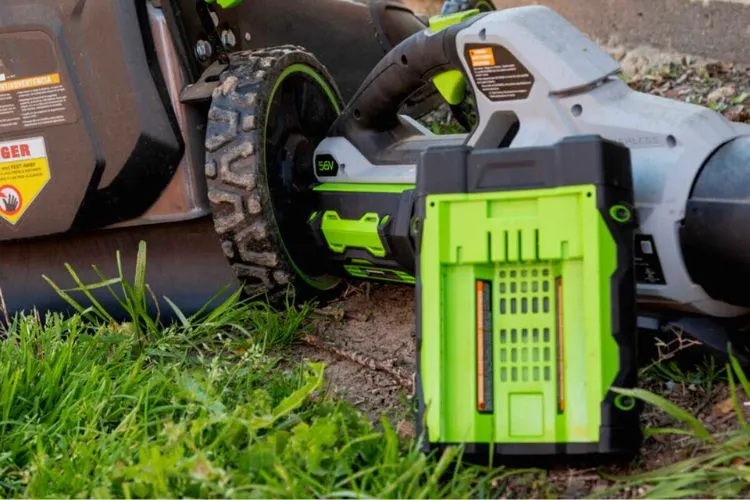
Table of Contents
Explain How batteries charge and overcharge
Batteries are essentially an accessory that store a form of chemical energy. A chemical reaction occurs when a flow of electrons enters the battery via an outside power source (electrode). As this reaction occurs, the power is converted into usable electrical energy.
A battery can be charged or ‘powered up’ by sending through a higher voltage into the battery than it usually has. This creates the chemical reaction stored as chemical energy in the battery that is ready to use.
Lead-acid batteries in lawn mowers are no different, but the process is often called trickle charging. They are usually supplied with a continuous float voltage of around 13.7 volts.
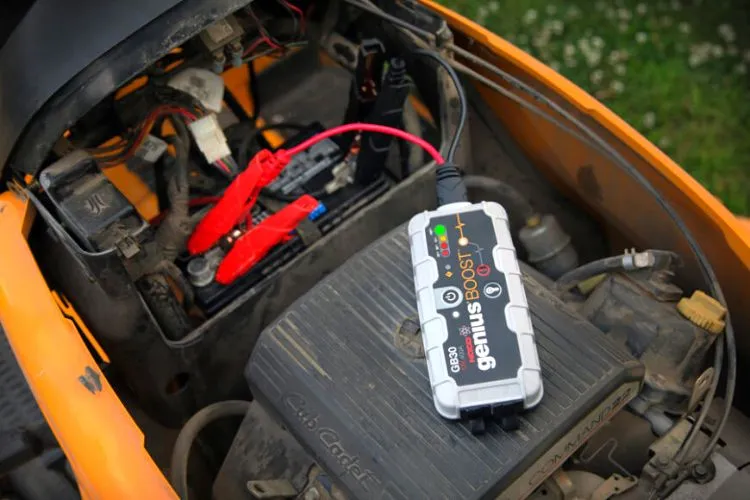
This amount is optimal for steady, safe charging and keeps the battery at a maintained charge level that is always ready to use. One of the biggest issues with batteries is when they become overcharged. This often occurs when either the charger or the protection circuit doesn’t stop the charging process via a fault.
As a result, too much energy enters the battery, which causes the voltage in the cell to rise. This will severely reduce the battery’s lifespan and is also quite harmful to the battery.
Can you overcharge a lawn mower battery?
You can overcharge a lawn mower battery, or any battery for that matter. Most heavy duty lawn mowers run on lead-acid batteries. These types of batteries can become easily damaged by using a charger that sends the wrong voltage into them.
Another reason for fast dying batteries is excessive charging. It’s extremely important to either use the charger that came with the battery or one that is only suited to that specific battery.
Furthermore, checking for faults regularly will help prevent any charging issues in the future.
Excessive charging is an easy mistake as most people simply throw their batteries on the charger and leave them until they need them next. It’s best to use a trickle charger where the battery charges as it is used and slowly adds charge over a long period.
Or an automatic charger shuts the power off when the battery is fully charged. These 2 devices are great in fighting against batteries becoming overcharged.
Consequences of overcharging a lawn mower battery
It’s not always easy to have your gardening gear in top condition. Sometimes life just gets in the way. However, committing something as simple as overcharging your lawn mower’s battery in the name of convenience or accident can have some pretty irritating consequences.
Namely the reduction in overall charge capacity as well as a reduced lifespan. Furthermore, some other issues, such as leakage, explosions, or fires, can lead to dangerous outcomes.
Let’s look at some of the most common consequences of overcharging a lawn mower battery.
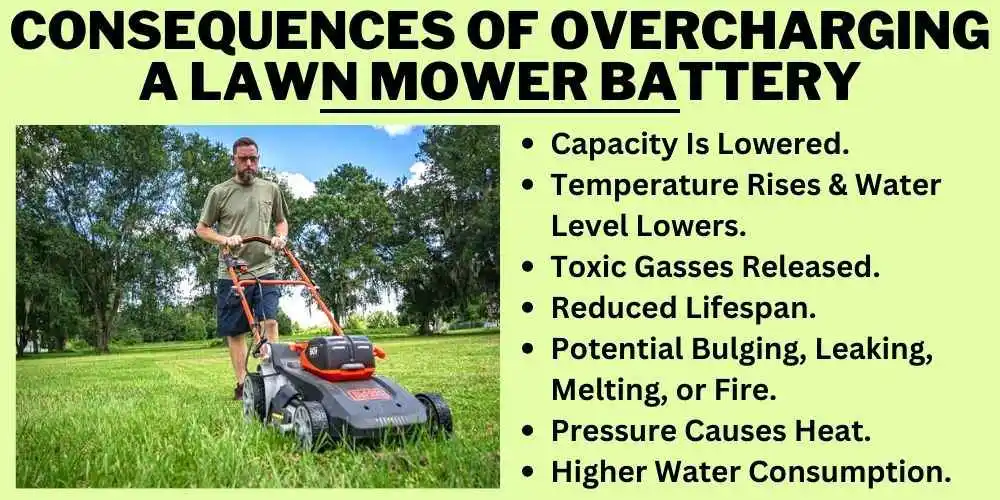
Capacity Is Lowered
One of the first symptoms of an overcharged battery is its deteriorating ability to hold a charge. Meaning to be charged to full capacity but have less power to use than normal.
This issue can usually fly under the radar as it is more of a lightly progressive consequence. Overcharging causes corrosion within the battery, which reduces its overall effectiveness and efficiency.
Temperature Rises & Water Level Lowers
When lead-acid or lithium-ion batteries get hot from overcharging, they can succumb to the damage of a process known as a thermal runway. This occurs when the battery breaks down and causes the temperature to rise much more than usual.
When the battery heats up, the water and sulphuric stored inside start to evaporate and boil as a result of this chemical reaction. As a result, the battery is put under enormous pressure and cannot relieve it. This makes the battery a possible explosive risk.
Toxic Gasses Released
Lead-acid batteries produce hydrogen gas. As these gasses build up and cannot ventilate, they become an explosive risk.
But that’s not the only gas they release; some batteries contain dangerous hydrogen sulfide gasses that, when damaged, can affect the air we breathe in. Inducing small amounts can cause toxic illness, whereas breathing in larger amounts can be fatal.
Reduced Lifespan
Overcharging a battery reduces its lifespan by simply making it work harder than designed. When a battery is overcharged, it is forced to take in and disperse more power than it should.
This means it is always ‘working’ instead of just functioning in an organized manner. As a result, the battery’s life is severely diminished.
Potential Bulging, Leaking, Melting, or Fire
Most batteries, whether lead-acid or lithium-ion, have temperature sensors to help mitigate issues caused by overcharging. However, over time, these components begin to weaken and lose their sharpness and ability to maintain a healthy charge level.
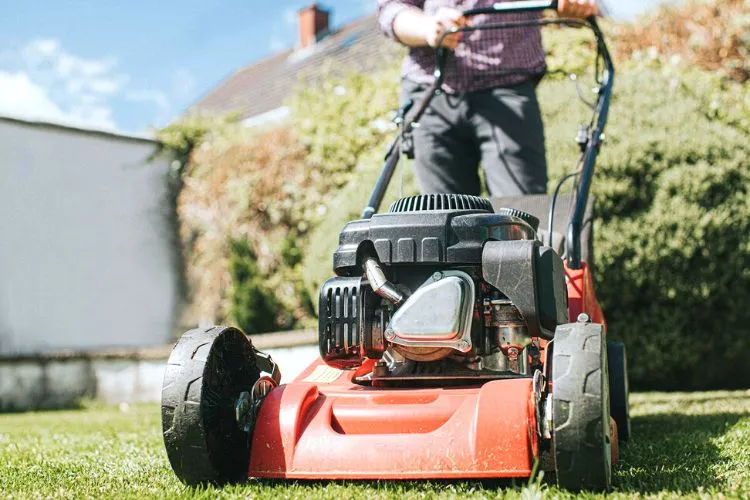
As a result, the battery can bulge (sustain damage from built up pressure). Once bulging occurs, a range of more damaging issues come to light. These include leaking (as components break down), melting and then fire (depending on how damaged the battery becomes).
Pressure Causes Heat
As the battery warms up, it builds up pressure due to the thermal runway. Once this occurs, a cycle occurs between pressure causing heat and heat causing pressure. Until, of course, the battery can’t take any more pressure and can explode as a result of poor maintenance.
Higher Water Consumption
When the electrolytes of a battery decompose, they can cause a ‘gassing’ effect. This is the amount of battery that is swollen when overcharged.
As this gassing occurs, the water evaporates much faster and causes the battery to become less effective. In most cases, more water must be added to the battery to ensure it functions at full capacity.
How to prevent overcharging a lawn mower battery?
As frustrating as it is to prepare for a big day out tackling a lawn with a diminishing lawn mower battery, there are ways you can prevent any overcharging issues. Let’s go through some great tips and practices for keeping your batteries in good working order.
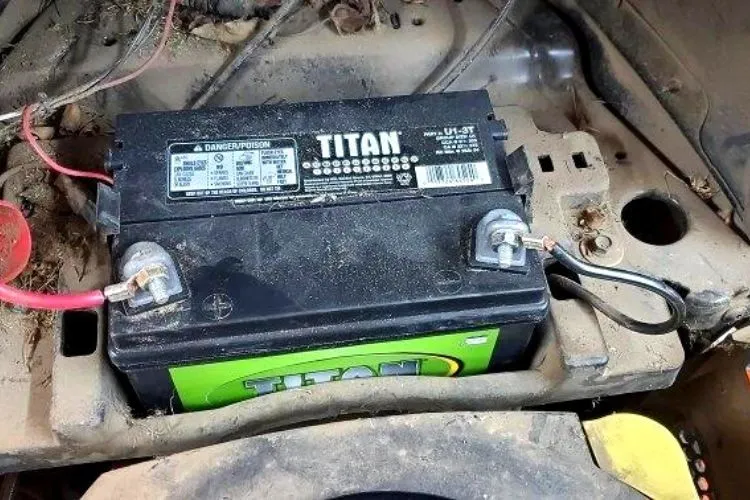
Choose a charger that is appropriate for the specific battery
Every battery has a power rating which is measured in kilowatts. This rating shows how much power can flow in and out of the battery at any given time. Furthermore, batteries also contain certain amounts of voltage. A few different factors determine this fundamental battery characteristic. They include:
- Chemical reactions in the battery.
- The type and range of the battery components.
- The polarization of the battery.
It’s very important to choose a charger that suits both measurements. Otherwise, it can throw the balance out and cause overcharging, leading to a range of problems.
However, it is possible to use specifically designed chargers that contain built-in voltage regulators. These devices help maintain a power source’s voltage within acceptable limits. It helps to keep the voltage at the desired amount to prevent overcharging.
Monitor and maintain the battery
It’s so easy (and convenient) to put your batteries on charge and leave them there until the next time you need them. Doing so, though, is a surefire way to ruin your batteries.
The best way to avoid this is to make sure that you go back and check on the charger every 30 mins to check that it has completed its charge and then switch the charger’s power off.
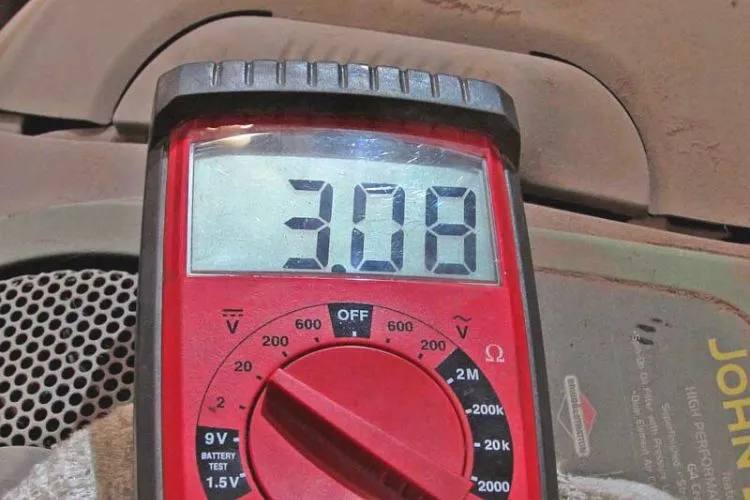
Furthermore, always check the battery’s temperature to ensure it isn’t boiling. This will also reduce its longevity if done too often. Even a marginally hot battery can be detrimental to its health.
Use a smart charger
Smart chargers are an amazing piece of technology worth their weight in gold. They aim to help prevent overcharging by automatically switching to a maintenance charge mode when necessary. Most variants work in 3 stages.
- Stage 1 (Bulk Charging) – Charges up to 80% full with high voltage and amperage.
- Stage 2 (Absorption Charging) – Detects the levels required to continue. Lowers the amperage whilst maintaining voltage to slowly and safely continue with the charge up to 85-95% (depending on the charger).
- Stage 3 (Float/Maintenance Charging) – The voltage slowly tapers down, and the charger trickles the power up to 100% (Full charge)
Use a battery tender
Battery tenders are another handy device that can help charge a battery without reaching the point of overcharging. They contain an electronic voltage regulator and a timer system that stays connected to the battery at all times to keep it charged even when in storage.
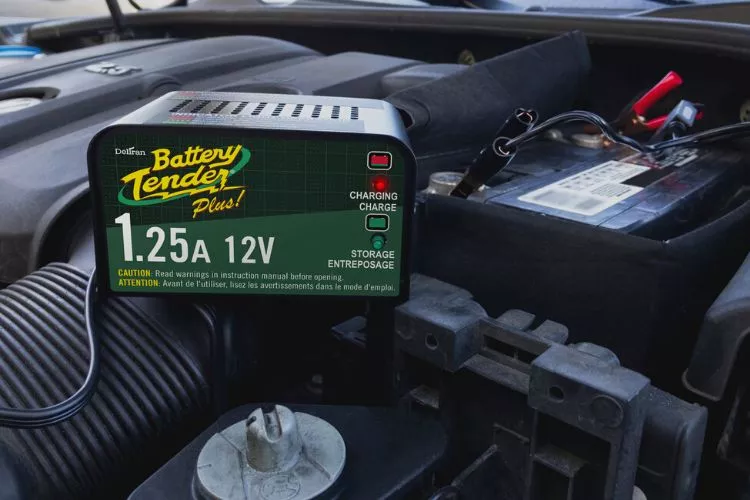
Battery tenders will not affect a dead battery, whereas a battery charger jump starts a dead battery. One of these on your lawn mower battery can help extend its lifespan.
Install an Overcharge Protection Circuit
An overcharge protection circuit works by using and protecting a secondary battery. The circuit controls the second battery by toggling an override control switch on and off. It charges the current that flows through to the secondary battery from the charging source.
The backup battery is connected between a main power source terminal and a grounded terminal. This ensures that the battery can never become overcharged, instead just charged enough to ensure that it continues to maintain a healthy level of power.
How to troubleshoot and fix an overcharged lawn mower battery?
If you suspect that your lawn mower battery has been overcharged, there are several things you can do to correct the issue. However, it isn’t always possible to fix, as we explain below. Let’s walk through some simple steps to try to troubleshoot the problem.
Ascertain if overcharging is the problem
There are a few ways to work out if your lawn mower battery is overcharged. These include:
- The battery gets hot whilst charging.
- The lawn mower lights stutter and turns off soon after they are turned on.
- The battery is bulging from all sides.
Last Attempt – You can try to start the lawn mower, and if it doesn’t hold a charge, check that the connections are clean and tight, then attempt to reconnect to the charger. If it doesn’t charge completely after letting it power up for 8 hours, there is nothing you can do to bring it back.
Restoring the battery
Restoring your battery can go 2 ways. You can either tinker with it yourself (if you’re confident) or simply replace it. If you are a tinkerer, here is a little guide to get you through the process:
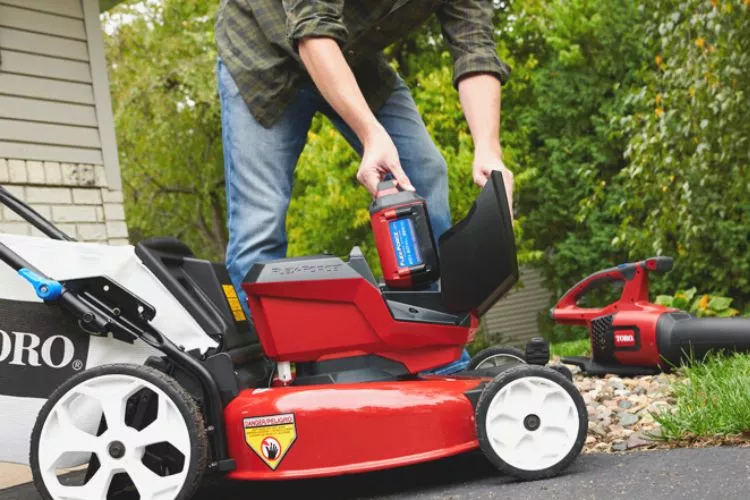
- Disconnect the battery and completely remove it from your lawn mower.
- Remove the battery’s cover caps.
- Drain out and thoroughly clean the battery.
- Mix a solution with 1 part magnesium sulfate (epsom salt) and 3 parts warm, distilled water.
- Add the solution (electrolyte) to each of the battery cells. Ensure that the plates are covered by ¼ to ½ of the solution.
- Attempt to charge as usual and begin the battery cycle.
- If it still doesn’t hold a charge, then unfortunately, there is no way to revive it. It’s best to cut your losses and purchase a new battery.
Frequently Asked Questions (FAQs)
How often should I charge my lawn mower battery?
Most manufacturers recommended receiving a maintenance charge once per month during summer and once a week during the cooler months. This ensures that the charge it holds doesn’t sit stagnantly and the chemical reaction continues to move around.
If you use your lawn mower often, it’s best to only charge when necessary. This could mean fully charging after each use and switching the power off when the charge is complete.
Should we Overcharge or Undercharge a Battery?
It’s not recommended to do either. Undercharging can cause just as many problems for the battery as overcharging does. Undercharging causes the copper to corrode, which shorts the power if done consistently. Overcharging puts a heap of stress on the battery, which causes bulging, gas leaks and even become a fire risk.
How Long Does a Lawn Mower Battery Last?
An exceptionally maintained lawn mower battery can last up to 4 or 5 years. General maintenance includes minimizing corrosion, never under or overcharging, and keeping the battery and its charger safe from extreme weather, such as heat and chills.
Conclusion:
If your lawn mower isn’t holding charge or its lights are stuttering, it’s more than likely suffering from the after effects of overcharging. You can take a few tinkering actions to ascertain that the problem has to do with the battery.
However, if the battery doesn’t pass these simple tests, it is almost no way to recover it. In this case, purchasing a new one is the best course of action. As cliche as it sounds, the best way to prolong the life of your lawn mower battery is simply to maintain it.
Use the right charger for the right battery and use measures to control the charge where necessary. We hope that this guide has been helpful. You can read about similar topics here on our website. Check back again soon for more.

